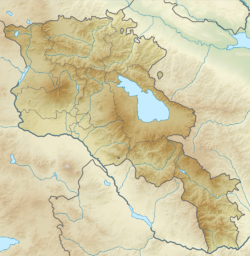
Back زلزال أرمينيا 1988 Arabic Ruftacek ke Spitak (1988) AVK Spitak zəlzələsi Azerbaijani Спітакскае землетрасенне Byelorussian Землятрус у Армэніі (1988) BE-X-OLD Арменско земетресение Bulgarian Zemětřesení v Arménii 1988 Czech Erdbeben von Spitak 1988 German Αρμενικός σεισμός του 1988 Greek Spitaka tertremo Esperanto
| UTC time | 1988-12-07 07:41:27 |
|---|---|
| ISC event | 417441 |
| USGS-ANSS | ComCat |
| Local date | December 7, 1988 |
| Local time | 11:41:27 AMT |
| Duration | < 20 seconds[1] |
| Magnitude | 6.8 Ms[2] |
| Depth | 5 km (3.1 mi)[2] |
| Epicenter | 40°59′13″N 44°11′06″E / 40.987°N 44.185°E[2] Nalband, Armenian SSR, Soviet Union (present-day Shirakamut, Lori Province, Armenia)[3] |
| Type | Thrust |
| Areas affected | Soviet Union |
| Max. intensity | MMI X (Extreme)[2] MSK-64 X (Devastating)[4] |
| Peak acceleration | 0.6–0.7 g at Spitak (est)[5] |
| Aftershocks | 5.8 ML December 7 at 11:45 AMT[6] |
| Casualties | 25,000[7]–50,000[8][9] dead 38,000 dead (2017 estimate)[10] 31,000[11]–130,000[9][12] injured |
The 1988 Armenian earthquake, also known as the Spitak earthquake (Armenian: Սպիտակի երկրաշարժ, romanized: Spitaki yerkrasharzh), occurred on December 7 at 11:41 local time with a surface-wave magnitude of 6.8 and a maximum MSK intensity of X (Devastating). The shock occurred in the northern region of Armenia (then Armenian SSR, as part of the Soviet Union) which is vulnerable to large and destructive earthquakes and is part of a larger active seismic belt that stretches from the Alps to the Himalayas. Activity in the area is associated with tectonic plate boundary interaction and the source of the event was slip on a thrust fault just to the north of Spitak. The complex incident ruptured multiple faults, with a strike-slip event occurring shortly after the initiation of the mainshock. Between 25,000 and 50,000 were killed and up to 130,000 were injured.
Seismologists thoroughly studied the effects of the Spitak event, including the mainshock and aftershock fault rupture mechanisms, and were on site setting up temporary seismometers before the end of 1988. Earthquake engineering experts scrutinized building construction styles and found fault in the poorly constructed apartments and other buildings that were built during the Era of Stagnation under the rule of Leonid Brezhnev. The cities of Spitak, Leninakan (Gyumri) and Kirovakan (Vanadzor) were greatly affected with large losses of life and devastating effects to buildings and other structures. A number of the smaller outlying villages away from the larger population centers were also severely affected.
Despite the tensions of the Cold War, Soviet leader Mikhail Gorbachev formally asked the United States for humanitarian help within a few days of the earthquake, the first such request since the late 1940s. One hundred and thirteen countries sent substantial amounts of humanitarian aid to the Soviet Union in the form of rescue equipment, search teams and medical supplies. Private donations and assistance from non-governmental organizations also had a large part of the international effort. While transporting some of these supplies to the region, a Soviet aircraft carrying 9 crew members and 69 military personnel, and a transport plane from Yugoslavia, were both destroyed in separate incidents. In support of the relief effort, recording artists united to produce several music-related contributions for the victims of the quake. A song was produced by a duo of French composers (including Charles Aznavour) and a studio album that featured songs donated by mainstream rock bands was released from the Rock Aid Armenia effort by the British music industry.
- ^ Wood et al. 1993, p. 256
- ^ a b c d Cite error: The named reference
NGDCwas invoked but never defined (see the help page). - ^ Harutyunyan, Arpi (December 7, 2007). "Still Recovering: A visit to the 1988 "center of the epicenter"". ArmeniaNow. Archived from the original on July 10, 2020. Retrieved March 7, 2014.
- ^ Cisternas et al. 1989, p. 675
- ^ Wood et al. 1993, p. 259
- ^ Cite error: The named reference
Cisternas_p676was invoked but never defined (see the help page). - ^ Cite error: The named reference
Servicewas invoked but never defined (see the help page). - ^ Cite error: The named reference
nyt_Dec10was invoked but never defined (see the help page). - ^ a b Cite error: The named reference
Time_Dec26was invoked but never defined (see the help page). - ^ Mikayelyan, Hrant (December 9, 2017). "Сколько на самом деле погибло людей в результате спитакского землетрясения?" (in Russian). Caucasian Knot. Archived from the original on February 27, 2019.
Таким образом, численность погибших следует оценивать в 38 тыс. чел.
- ^ Cite error: The named reference
Wood_p253was invoked but never defined (see the help page). - ^ Cite error: The named reference
J_Epid_97was invoked but never defined (see the help page).
